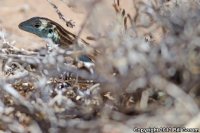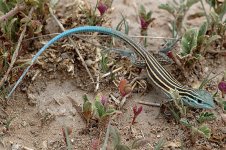| Range: |
 |
| Other Names: |
|
| Subspecies: |
Trans-Pecos Striped Whiptail Aspidoscelis inornata heptagramma occurs from extreme southern NM throught Trans-Pecos Texas and eastern Chihuahua, Mexico. Usually has 7 complete stripes.
Woodland Striped WhiptailAspidoscelis inornata junipera occurs in eastern and northwestern NM. Usually has 7 complete stripes.
Plains Striped Whiptail Aspidoscelis inornata llanuras occurs in the Rio Grande Valley and nearby areas in central and southern NM. Generally lacks the seventh (middorsal) stripe. |
| Description: |
Slender lizard with a comparatively long tail, about 3 times the head-body length. Small, granular dorsal scales with enlarged scales on back of forelimbs and along the front edge of throat fold. Belly with 8 rows of large, rectangular scales. Dorsal ground color dark gray or black. Dorsal pattern consists of 6-8 light stripes that run from the head onto the tail; no spots occur between the stripes. Blue coloration on sides of head. Ventral surface blue, though adult males have much deeper blue on ventral surface than females. Adult Aspidoscelis inornata grow to 11-24 cm (6.5-9.5 in). |
| Similar Species: |
The best way to distinguish between the other subspecies is by range. The Chihuahuan Spotted Whiptail, Gila Spotted Whiptail, Texas Spotted Whiptail, and Sonoran Spotted Whiptail all are distinctly spotted in the dark dorsal fields. The New Mexico Whiptail lacks the vivid blue suffusion of body color, usually some spotting in the dark dorsal fields, and has a distinctly wavy vertebral stripe. The Prairie Racerunner is bright green over the anterior portion of the body and lacks the bright blue suffusion elsewhere, and has conspicuously enlarged mesoptychial scales. The Plateau Striped Whiptail lacks the bright blue suffusion of body color and blue tail, occasionally has spots in the dark dorsal fields, usually has more than three enlarged preanal scales, and usually has conspicuosly enlarged mesoptychial and postantebrachial scales. The Desert Grassland Whiptail usually has six longitudinal light stripes, lacks the bright blue body color and blue tail, and has abruptly enlarged mesoptychial and postantebrachial scales. |
| Venom: |
None |
| Habitat: |
Aspidoscelis inornata can be seen on rocky slopes or grassy flatlands in arid and semi-arid environments. It is sometimes seen in sandy soil environments. |
| Behavior: |
This diurnal lizard is wary of being approached, and will hide under vegetation or in a burrow if threatened. |
| Hibernation: |
Underground durung the cool months |
| Reproduction: |
Breeding occurs in the spring and eggs are laid from May to July. Females lay 2-4 eggs. Hatchlings have a pale blue venter. |
| Diet: |
large insects and spiders |
Adapted from account on 
















